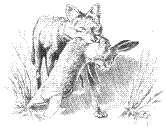Center, Internet, Wildlife Damage Management

Coyotes in the Southwest: A Compendium of Our Knowledge (Symposium Proceedings, 1995)
Date of this Version
January 1995
Document Type
Proceeding
Citation
Published in Coyotes in the Southwest: A Compendium of Our Knowledge, Symposium Proceedings, December 13–14, 1995, San Angelo, Texas
Edited by Dale Rollins, Calvin Richardson, Terry Blankenship, Kem Canon, and Scott Henke
Abstract
Coyotes (Canis latrans) and pronghorn (Antilocapra americana) have co-existed for thousands of years, but in today's production-oriented society the Pronghorn may need some help periodically. Although pronghorn numbers have rebounded dramatically since the early 20th century, continued management of this species is necessary and may include management of its primarily predator, the coyote. Pronghorn defense mechanisms offer protection from predators, but the coyote's hunting strategies overcome these mechanisms The Trans-Pecos region of Texas holds the greatest numbers of pronghorn In the state. Ranchers in the Trans-Pecos can use predators, such as rainfall; strategies, such as proper livestock stocking rates and pasture deferment; and tools, such as predator control, to help manage pronghorn populations in the presence of coyotes.


Comments
Published 1996, Austin, Texas. Used by permission